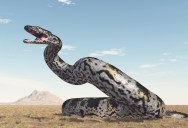This Prehistoric Snake Could Be The Largest To Ever Live On Earth At 49 Feet in Length

Snakes give a lot of people the heebie jeebies, but in all honesty, they kind of get a bad rap.
Sure, they’re kind of creepy, but most of them are perfectly harmless to humans.
That said, I wouldn’t have wanted to encounter this giant slitherer when I didn’t have a door I could lock behind me.
This newly discovered species of snake would have been over 49 feet in length and rivaled the size of the Titanoboa, which currently holds the title.
It’s a member of the Madtsoiidae family, which is now extinct, but once lived in the Indian subcontinent. It’s been named Vasuki indicus as an homage to a mythical Hindu snake.

Researchers at the Indian Institute of Technology Roorkee made the discovery of the fossilized remains at a coal mine in western India.
In their paper, they describe 37 well-preserved vertebrae, each around 2.5 inches in length.
Whether or not it would have actually been larger than Titanoboa, there’s no doubt it was an absolute unit.
The largest modern day snake grows only to about 25 feet and 2 inches in length.
Given its size, researchers believe it would have been an ambush predator, hunting in a way similar to an anaconda or a python – too large to really move quickly, says Debajit Datta and Sunil Bajpai.
“As Vasuki was terrestrial/semi-aquatic, it is possible that this extinct snake preyed on a variety of animals similar to modern-day pythons. It is difficult to say at this point precisely what sort of animals Vasuki preyed upon. However, it is to be noted that associated fossils of rays, sharks, catfish, turtles, crocodiles, and primitive whales were found in the same rock unit that yielded the remains of Vasuki. No land mammals were found.”
Scientists believe there are a few reasons ancient and prehistoric animals grew to larger sizes than their modern descendants. Things like oxygen levels, an abundance of plants, and natural selection could all have played a part.

Also, the Earth was significantly warmer and better suited to supporting large cold-blooded animals.
“A possible reason for its large size could be the comparatively higher mean annual temperatures in Earth’s history than today. Since snakes are poikilotherms, theri body temperatures are dependent on the temperature of their ambient environment, which in turn controls their body size. Therefore, higher ambient temperature can support snakes with large body sizes.”

There was also a lack of other aggressive predators in the time and place where it lived.
“Another possible reason for the smaller size of present-day snakes could be the combined effect of habitat loss (due to deforestation and human encroachment) and poaching which may have removed exceptionally large-bodied snake lineages from the present-day ecosystem.”
Whatever the reason, this thing had to be fearsome to behold.
I have to imagine it would have snacked on a human or two if they had managed to cross paths in history.
Thankfully for us, we didn’t.
Thought that was fascinating? Here’s another story you might like: Why You’ll Never See A Great White Shark In An Aquarium

Sign up to get our BEST stories of the week straight to your inbox.




